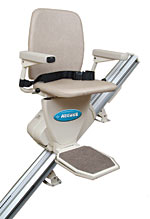Harmar Puts the Stairlift on a Diet
- By David Kopf
- Nov 01, 2008
 The slimmed-down Pinnacle ensures easy access for everyone in the home.
The slimmed-down Pinnacle ensures easy access for everyone in the home.For decades, stairlifts have helped older individuals and those with mobility limitations safely overcome staircases that would otherwise represent almost insurmountable obstacles. However, stairlifts themselves can then become an obstacle for other people who need to use the same staircase.
Keeping that in mind, Harmar Access has released the Pinnacle, a svelte new stairlift that folds up when not in use.
“One of the things about stairlifts is that consumers can often find them intrusive, and that they take up a little more space on their stairs than they want them to,” says Sarah Penix, business development manager for Harmar. “They want to have a stairlift and be able to use it, but they don’t want it to be an obstruction.”
Small on Size, Big on UsabilityWhen the Pinnacle’s footrest and seat are folded up, the unit only extends a maximum of 11 inches from the wall, Penix says. “Without a doubt it is the narrowest in the industry by at least 3 to 4 inches,” she adds.
A key component to the Pinnacle is its helical worm drive system, which Penix says is the “narrowest in the industry.” Because the helical drive keeps five teeth on the track at all times, the Pinnacle provides a smooth ride with no jerking or bumping, and is light on maintenance. It requires no lubrication as it is self-lubricated, which makes it easier to keep clean and maintained.
The light weight and small drive also help the chair to use 75 percent less energy than a typical lift, Penix adds.
While the slimmed-down stairlift folds up small and rides on a narrower track, that does not diminish its carrying capacity. The standard Pinnacle can carry up to 350 pounds, like Harmar’s other stairlifts, according to Penix.
Length is not an issue for the Pinnacle, either. The track comes standard at 16 feet, but comes in lengths up to 70 feet. The chair is non-handed, so the rail can be mounted on either side of the stairs, and since the chair arrives on the rail, the provider doesn’t have to touch the chassis during installation.
Using the ChairWhen the footrest is folded out, the chair chassis extends to a roomy 23.5 inches, more than double its folded width. The chair back extends all the way down the chair, and all the surfaces are cushioned.
In terms of control, rather than having a rocker switch on the armrest, the Pinnacle provides a joystick.
“Basically, you have the option of pushing the button with a finger, the way you would normally do it, or you can use the joystick, which can be operated by either side of the hand or the finger,” Penix explains. “So for people with, say, arthritis or MS, it gives them more options.”
In addition to the joystick, the stairlift also comes with a wireless “call and send control,” to let the user fetch or send the chair without having to use wall-mounted switches. (Although users still have the option of using wall switches.)
The chair comes with several touch-sensitive obstruction sensors to halt the chair when its path is blocked. This can be especially handy when children are in the house and toys are in the chair’s path.
“If there’s anything in the way of the chair, it is going to stop automatically,” Penix adds.
Also, the Pinnacle comes with a safety belt that secures around the user’s waist and a removable key lock, to ensure it can’t be used when the owner is away from the home.
An Expanding Stairlift MarketplaceThe chair helps address the need of a growing segment of the homecare market: Baby Boomers who are taking care of their older parents, who might not necessarily have severe mobility limitations, but have difficulty safely or easily negotiating stairs. Why should they move out of their home just because they can’t easily or safely use the stairs?
“Not only does it give the individual [using the stairs] security and safety, but it also gives the rest of the family peace of mind,” Penix says. “You don’t want to have to be worrying in the middle of the night, ‘Are they going to fall? Am I going to get one of those horrible phone calls?’”
That’s doubly important considering that in a down housing market, many people are not in a position to sell their homes in order to move into a single-level dwelling or assisted-living facility.
Harmar Access(866) 351-2776
www.harmaraccess.com
This article originally appeared in the November 2008 issue of HME Business.
About the Author
David Kopf is the Publisher HME Business, DME Pharmacy and Mobility Management magazines. He was Executive Editor of HME Business and DME Pharmacy from 2008 to 2023. Follow him on LinkedIn at linkedin.com/in/dkopf/ and on Twitter at @postacutenews.